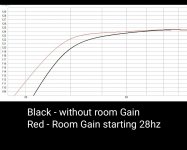Hi guys ... Please see the attached image.
This is a Winisd simulation of a ported sub.
Black - without room Gain
Red - with room Gain starting from 28hz
Now the question is ...
1. Is the increase in SPL due to room Gain looks realistic ??
I mean how close is the Winisd estimation to the real world.
2. Room Gain works differently for sealed and ported subs ??
This is a Winisd simulation of a ported sub.
Black - without room Gain
Red - with room Gain starting from 28hz
Now the question is ...
1. Is the increase in SPL due to room Gain looks realistic ??
I mean how close is the Winisd estimation to the real world.
2. Room Gain works differently for sealed and ported subs ??
Attachments
Depends on the room, placement, materials of walls/ceiling/floor, number of floors under the room in question, neighbouring rooms +++
It's a gross simplification, don't rely on room gain, consider any gains an un-expected bonus.
It's a gross simplification, don't rely on room gain, consider any gains an un-expected bonus.
It depends on directivity and therefore works the same for all monopole sources: seals, ported, bandpass, tapped horn etc. and all but the largest horns. For dipoles and cardioids it will be different.2. Room Gain works differently for sealed and ported subs ??
Last edited:
Now the question is ...
1. Is the increase in SPL due to room Gain looks realistic ??
I mean how close is the Winisd estimation to the real world.
I didn't realise WinISD had a room gain estimator built in, could you tell us more about that please?
If you've used some other method to estimate room gain and merely simulated the outcome of that by adding a PEQ (or modifying a Linkwitz Transform perhaps?) to get the same result, then the outcome will only be as accurate as the initial estimate of room gain.
That will obviously depend on room dimensions first but also speaker and listener position in room, rigidity of walls, amount and size of apertures (windows/doors passageways etc.
HTH,
David.
Hmm, there's room gain, which doesn't begin until below the room's lowest mode and there's room boundary gain that's a function of how close to a boundary the speaker is.
Hornresp and others I've used only consider the latter, i.e. the pi space locations, so wondering if this is what WinISD has; or does it require inputting the room's 3D dimensions?
Hornresp and others I've used only consider the latter, i.e. the pi space locations, so wondering if this is what WinISD has; or does it require inputting the room's 3D dimensions?
Just measure your room gain. It's pretty simple, subtract a near field measurement from a listening position measurement.
I didn't realise WinISD had a room gain estimator built in, could you tell us more about that please?
If you've used some other method to estimate room gain and merely simulated the outcome of that by adding a PEQ (or modifying a Linkwitz Transform perhaps?) to get the same result, then the outcome will only be as accurate as the initial estimate of room gain.
That will obviously depend on room dimensions first but also speaker and listener position in room, rigidity of walls, amount and size of apertures (windows/doors passageways etc.
HTH,
David.
Hope this below video helps in understanding Room gain in Winisd
Free Bass! Subwoofer Room/Cabin Gain: What it is and how to model it with WinISD - YouTube
AgreeJust measure your room gain. It's pretty simple, subtract a near field measurement from a listening position measurement.
It will be nowhere near a smooth low shelving filter in most rooms, especially if the room has hard brick or concrete walls.
- Home
- Loudspeakers
- Subwoofers
- Room Gain for ported subwoofer
